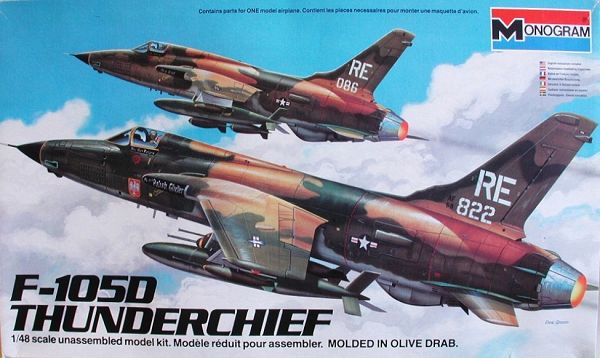
|
KIT: |
Monogram 1/48 F-105D Thunderchief |
|
KIT # |
5812 |
|
PRICE: |
$8.50 (back in 1985) |
|
DECALS: |
One aircraft |
|
REVIEW: |
|
|
NOTES: |
Initial Issue` |

|
HISTORY |

Even as sub-sonic F-84Fs began rolling off the assembly line at Republic’s Farmingdale facility on Long Island, Alexander Kartveli and his design team began exploring a supersonic follow-on to the Thunderstreak. These machinations proceeded as a private venture since no official Request For Proposal (RFP) or Specific Operating Requirement (SOR) had been issued by the Air Force. Using baseline performance figures from the F-84F as a datum point, it was Kartveli’s intent to capitalize on the then-recent advances in both jet turbine and electronic guidance technologies which seemingly occurred on a near-daily basis.
Due to the Tactical Air Command’s (TAC) new emphasis on nuclear deterrence, the provisionally-designated AP-63 was envisioned at the outset as a strike aircraft with a secondary air-to-air capability. Not coincidentally, the plane was designed with an internal weapons bay capable of carrying the latest generation of free-fall thermonuclear bombs. Hardpoints under each wing and the fuselage would permit carriage of additional ordnance (both ‘special’ and conventional) or auxiliary fuel tanks to increase the combat radius or ferry range. General Electric’s new twenty-millimeter Gatling gun with a 1075-round magazine was featured as the aircraft’s primary air-to-air weapon.
The intended powerplant was to be Pratt & Whitney’s new J-75 with afterburner, though delays with this engine forced Republic engineers to consider the lesser-powered Allison J-71. When the Air Force was invited to inspect the AP-63 mock-up in late 1952, the service directed a powerplant change to the P & W J-57, much to the lament of Kartveli and his engineering staff. Later, performance problems with another new aircraft program would convince the Air Force to reconsider this decision.
 The airframe was a
straight-forward design, borrowing many features from Republic’s RF-84F
Thunderflash; a solid nose, wingroot-mounted intakes, swept wings and empennage,
and tricycle landing gear. In an attempt to eliminate transonic buffeting
problems the all-flying tailplane was mounted low at the rear of the un-tapered
fuselage. The cockpit canopy featured the company’s trademark fixed
quarter-panel windows, though the canopy hinge was redesigned to swing directly
open, as opposed to the Thunderstreak/flash’s articulated pivot system.
The airframe was a
straight-forward design, borrowing many features from Republic’s RF-84F
Thunderflash; a solid nose, wingroot-mounted intakes, swept wings and empennage,
and tricycle landing gear. In an attempt to eliminate transonic buffeting
problems the all-flying tailplane was mounted low at the rear of the un-tapered
fuselage. The cockpit canopy featured the company’s trademark fixed
quarter-panel windows, though the canopy hinge was redesigned to swing directly
open, as opposed to the Thunderstreak/flash’s articulated pivot system.
The aircraft would be equipped with the latest in communication, navigation, and weapons delivery systems to permit limited all-weather operation. To increase the range a retractable probe was included to permit aerial refueling via the British-designed ‘probe and drogue’ method from KB-29, KB-50, and KC-97 tankers. Conventional speedbrakes were eschewed in favor of a segmented ‘petal’ arrangement at the rear of the fuselage surrounding the tailpipe, while landing roll-out was to be decreased by means of a drag chute mounted at the base of the rudder. A ventral fin below the tailplane would provide additional directional stability.
Meanwhile, just as the Air Force approved Republic’s J-57-powered design for prototype development , Convair’s similarly-powered YF-102 interceptor flew into a brick wall—figuratively. The lighter Delta Dagger, presumably with a higher thrust-to-weight ratio, could not exceed or even attain Mach 1! A major redesign of the F-102, to include the NACA-developed ‘area rule’ concept, would be necessary to resuscitate Convair’s ailing interceptor. Needless to say, Republic viewed these developments with undisguised interest.
Kartveli and his staff hurriedly redesigned their fuselage, applying the ‘area rule’ theory in an attempt to insure supersonic performance for the new aircraft. Concurrently, initial developmental problems with the originally-intended P & W J-75 were solved and hedging its bets, the Air Force directed yet another powerplant change back to the J-75, leaving the orphaned Allison J-71 as an also-ran. As an aside, this anemic engine was used to upgrade the Navy’s fleet of McDonnell F3H Demons with predictably lackluster results.
With the design finalized, the Air Force ordered prototypes of the J-75-powered aircraft, designating them the YF-105A. In keeping with Republic’s tradition dating back to the P-47, the new plane was named the Thunderchief. Though the first flight of the prototype demonstrated Mach 1 performance, major and minor modifications were made in an effort to extract every ounce of potential from the airframe.
The most substantial of these were a redesign of the intakes, resulting in the characteristic forward-swept variable-geometry ducts. This alone upped top speed to Mach 2+ and afforded better overall engine performance throughout the flight envelope. To eliminate some directional stability problems the vertical fin was enlarged, both in height and chord, while the damper/buffer system for the horizontal stabilizer was upgraded with a more sensitive reactive feedback system.
These modifications necessitated a new designation, the F-105B, and after successful flight test trials, the Air Force placed a production order. The end of the Korean War and the new emphasis on ballistic missiles for strategic deterrence conspired to reduce the planned buy to 75 aircraft, including 13 pre-production test and evaluation articles. Early into the ‘B’ model’s production run the fixed quarter-panel windows were deleted as they did little to increase pilot visibility and were sometimes troublesome to maintaining cockpit pressurization.
 Though the F-105B
provided the Air Force with more-than-adequate capabilities and performance,
Kartveli was driven to develop still more. Service needs dictated true ‘24-7’
all-weather operation so the B model’s nose was lengthened 15 inches and
increased in diameter to allow replacement of the MA-8 Fire Control System with
the more versatile ASG-19 unit. The pitot tube was relocated from the port
wingtip to the new enlarged radome resulting in an overall length increase of 63
inches. A refueling receptacle was added to allow for compatibility with the Air
Forces’s new fleet of KC-135 jet tankers, located adjacent to the retractable
probe while ammunition capacity was slightly reduced to 1028 rounds.
Though the F-105B
provided the Air Force with more-than-adequate capabilities and performance,
Kartveli was driven to develop still more. Service needs dictated true ‘24-7’
all-weather operation so the B model’s nose was lengthened 15 inches and
increased in diameter to allow replacement of the MA-8 Fire Control System with
the more versatile ASG-19 unit. The pitot tube was relocated from the port
wingtip to the new enlarged radome resulting in an overall length increase of 63
inches. A refueling receptacle was added to allow for compatibility with the Air
Forces’s new fleet of KC-135 jet tankers, located adjacent to the retractable
probe while ammunition capacity was slightly reduced to 1028 rounds.
The Air Force, after ordering a perfunctory competitive ‘paper’ fly-off against a proposed McDonnell F-101 Voodoo upgrade, happily ordered this new Thunderchief variant, designating it the F-105D. Fifteen hundred aircraft were projected though the order was eventually pared to 610 which would equip seven tactical fighter wings plus the 4520th Combat Crew Training Wing and the 4537th Fighter Weapons Squadron based at Nellis AFB in Nevada. Concurrently, the Department of Defense decided to de-emphasize the nuclear "Big Stick" policy and decreed that TAC develop a conventional capability as its primary mission.
This edict resulted in several modifications and new equipment added to the Thunderchief fleet, the most visible of which was the multiple ejector rack (MER). Designed for ‘parent carriage’ on a wing or fuselage pylon, it allowed six weapons to be carried on a single station, thus increasing an aircraft’s effective payload (though the plane’s all-up ordnance weight limit remained the same). The MER (and later, the TER) would find its way to other aircraft, both Air Force and Navy. To increase the Thunderchief’s air-to-air capability, the new AIM-9 Sidewinder missile was certified for either single- or dual-rail carriage on the outboard stations.
A 390-gallon fuel cell was installed in the weapons bay to increase the combat radius with externally-carried conventional ordnance while a retractable arresting hook was added to the rear fuselage to permit barrier cable engagement on short runways or in the event of brake or drag chute failure due to battle damage. New wing pylons were configured to carry and launch a variety of air-to-ground missiles such as the Bullpup, Shrike and Standard ARM (the latter two generally reserved for the two-seat F-105F and later the ‘G’ Wild Weasel models).
The F-105D was one of the first frontline combat aircraft sent to Southeast Asia as the situation in South Vietnam approached the flashpoint of total US commitment in the early 1960s. Deployed to multiple bases in Thailand, Thunderchiefs (or ‘Thuds’, as their drivers were wont to call them) bore the brunt of the early bombing campaign north of the 17th parallel, which marked the nebulous DMZ mandated by the specious Geneva Accords of 1954. Early combat experience demonstrated the need for enhanced survivability features to counter increasingly prolific AAA and SAM threats. GCA-controlled interceptors were also a growing problem.
 As a result, the aircraft
were fitted with appliqué armor installed on the rear fuselage, while new
defensive avionic systems required additional antennas on the nose and fin. A
strike camera was added below the nose to record and score bombing performance,
while afterburner cooling scoops were installed at the waist. A pronounced
fairing on the dorsal side of the fuselage housed additional equipment and early
gun gas ingestion problems with the port intake duct required a redesign of the
gun access door to include multiple diffuser vents and baffles..
As a result, the aircraft
were fitted with appliqué armor installed on the rear fuselage, while new
defensive avionic systems required additional antennas on the nose and fin. A
strike camera was added below the nose to record and score bombing performance,
while afterburner cooling scoops were installed at the waist. A pronounced
fairing on the dorsal side of the fuselage housed additional equipment and early
gun gas ingestion problems with the port intake duct required a redesign of the
gun access door to include multiple diffuser vents and baffles..
As North Vietnamese air defenses grew in sophistication, the Thuds increasingly found opportunities to demonstrate their air-to-air prowess against NVAF MiGs, provided by their patron, the Soviet Union. A total of 27 confirmed MiG kills represents a small fraction of the complete MiG kill tally of the Vietnam War, but considering this score was amassed by a strike aircraft, it is remarkable indeed. A sizable portion of these victories were claimed by two-seat Wild Weasel versions, a testament to both the machine and their crews.
Combat attrition and training losses accounted for some 400 Thunderchiefs and by 1972 the F-105D had been withdrawn from combat, leaving only the Wild Weasel Thuds in Southeast Asia to support the remaining Air Force assets until the end of the war. Surviving ‘D’ models were refurbished at McClellan AFB in California and subsequently assigned to Reserve and Air National Guard units while thirty aircraft were modified with the ‘T-Stick II’ avionics package and assigned to the 23rd TFW based at McConnell AFB in Kansas (an active AF unit).
By the early 1980s these airframes began to exhibit serious structural problems and no economical method of ‘Inspect and Repair As Necessary’ (IRAN) or ‘Time Compliance Technical Order’ (TCTO) procedures could be developed to extend their service lives. In 1983 the Thunderchief passed into history as the units to which they were assigned began transitioning into F-4s, F-15s, and F-16s. A few airframes survive today as tributes and gate guardians but most were sent to the boneyard at Davis-Monthan, too tired even to be converted into drones.
|
THE KIT |
Monogram’s F-105D kit contains 85 parts molded in dark olive drab and a clear two-piece canopy and gunsight transparency. A roadmap-style instruction pamphlet offers a brief history of the Thunderchief, a painting guide annotated to Humbrol colors, sequential assembly steps, and a three-view drawing of the standard SEA camouflage pattern with FS 595a color specifications. The decal sheet contains markings for one aircraft; 59-1822, an F-105D-6-RE assigned to the 44th TFS, 355th TFW, Takhli RTAFB, circa 1970. Nicknamed "The Polish Glider", this plane was flown by Major Dan Kutyna.
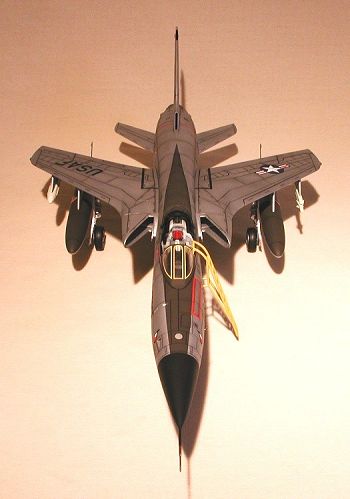 Typical of the vintage,
the surface detailing consists of raised panel lines, recessed control surface
demarcations, and recessed scoops, vents, and grilles. Monogram’s design
engineers obviously used a very late Thunderchief for their prototype as the
model wears the appliqué armor on the fuselage, along with the RHAW antennas on
the nose and vertical fintip, afterburner cooling scoops, and the nose-mounted
combat documentation camera.
Typical of the vintage,
the surface detailing consists of raised panel lines, recessed control surface
demarcations, and recessed scoops, vents, and grilles. Monogram’s design
engineers obviously used a very late Thunderchief for their prototype as the
model wears the appliqué armor on the fuselage, along with the RHAW antennas on
the nose and vertical fintip, afterburner cooling scoops, and the nose-mounted
combat documentation camera.
The wings are a hold-over from the company’s earlier F-105G release and have the wingtip-mounted RHAW antennas which must be removed for an accurate ‘D’ model. Additionally, structural ‘band-aid’ reinforcements are present, top and bottom, which were a post-war modification and, hence do not jive with the supplied Vietnam War era decals. In any event they are overly heavy and should be sanded to reduce them to scale thickness.
The four-piece cockpit reflects typical Monogram casting—the instrument panel and side consoles are well-depicted while the seat is oversimplified. The molded seat belts are very poor and the left console cries out for a throttle. A seated two-piece figure is provided and the canopy may be posed open or closed though fit difficulties may prove problematic with either option. The clear parts themselves are magnificent with all framing correctly molded. Three unused parts consist of an extra control column, seat, and an F-105G rear instrument panel. The sprue containing these items was also common to the Wild Weasel variant and the later F-105F release.
The kit is engineered with a center wing spar which is trapped between the fuselage halves and designed to maintain uniform anhedral while strengthening the wing root joints. The spar also forms a portion of the main gear wells and adds to the detail in this area. Each fuselage half has a portion of the intake duct molded integral to it in order to minimize seamwork in this highly visible area and provide additional structural integrity to the wings.
The landing gear is this kit’s crown jewels, as both wheels and struts along with the wells and doors are beautiful. Hub detail is outstanding while the tires are modestly treaded. The struts and wells feature a comprehensive fit of brakelines, actuators, hydraulic accumulators, and control rod dampers along with the correct auxiliary air intakes in the main wells. Additional plumbing in all the wells really dresses them out.
External stores consist of a pair of 450-gallon droptanks with integrally-molded pylons to be installed at stations 2 and 4. Outboard of those, separate pylons are furnished along with a pair of Mk 82 500-lb bombs with ‘daisy cutter’ fuse extenders to mount to them. A correct centerline pylon with an integral multiple ejector rack, along with six M-117 750-pounders rounds out the ordnance.
 The remaining parts amount
to some external scoops and vents, most of them severely dimpled, a set of VHF,
TACAN, and Doppler blade antennas to be installed beneath the fuselage behind
the nose gear well, the stabilators which plug into holes molded into the aft
fuselage, and a six-part tailpipe. The speedbrake petals are separate pieces
with the bottom section depicted in the fully deployed position.
The remaining parts amount
to some external scoops and vents, most of them severely dimpled, a set of VHF,
TACAN, and Doppler blade antennas to be installed beneath the fuselage behind
the nose gear well, the stabilators which plug into holes molded into the aft
fuselage, and a six-part tailpipe. The speedbrake petals are separate pieces
with the bottom section depicted in the fully deployed position.
The arresting hook is molded integral to the left fuselage half and begs for additional detail, while the fintip-mounted RHAW antenna is asymmetrically located between the right and left sides, providing a distinctly lop-sided presentation. Less-than-stellar mold engineering results in many control surface demarcation irregularities, mainly at the rudder and aileron trailing edges.
The standard-issue Monogram decals are typically mediocre and feature less than a tenth of the service stenciling required for a proper Thunderchief model. Not to fear though, as the F-105 has been adequately served by the aftermarket industry. Micro/SuperScale and Aeromaster offer multiple decals for the Thud, and for those who dare, a ‘nice and naughty’ sheet containing some of the bawdiest noseart ever worn by a warplane is available from Albatross.
|
CONSTRUCTION |
This article should more properly be titlled "Thunderchief: Redux". I had previously built an F-105D back in 1982, using the newly-released F-105G Wild Weasel as a starting point (a photograph of me holding this model appeared in the Fall 1982 issue of FSM). That model, while seemingly accurate, suffered from severe shape and proportional problems. Being the anal retentive sort that I am, I obsessed over this early effort, and ultimately gave the model to fellow F-89 Scorpion addict Mike Dario.
When starting this new build I decided to perform some scale measurements on the kit to try and isolate and fix the problems. After mocking up the airframe via masking tape I looked closely at the model using different lighting (direct and backlit) while rotating it through multiple angles. My perceptions amounted to a nose that was too short and incorrectly shaped. Instead of the near-straight line from the base of the pitot tube to the forward edge of the windscreen (as depicted in the kit), it should be a gently-tapering arc, with an ogive-shaped curve at the radome.
Another major area of contention concerned the wings. Republic’s specifications indicate three degrees of anhedral, while Monogram’s kit parts as issued deliver about ten degrees. The results of this are pylons which will not correctly install parallel to the fuselage vertical centerline and main landing gear struts which will mount bow-legged if the excessive dihedral is not addressed.
Clearly, a good set of properly-drawn scale plans were needed, and after disassembling the mock-up I enlarged the 1/72nd scale plans in Lou Drendel’s Thud book by 50% and laid the parts on their respective views. Save for the horizontal stabilizers, nothing jived up!
Here’s what happened… The overall fuselage length matched but the distance from the base of the pitot tube to the rear of the cockpit was too short. Consequently the rest of the fuselage was too long and also too deep. The vertical fin was too tall and too broad in chord (matching perfectly the discrepancy with the aft fuselage). The wings scaled out one foot too long (each) and were also too broad in chord, as well as having some minor shape problems at the trailing edge of the flaps.
I decided that if I could just fix the nose and anhedral problems with the wings I might get a passable Thunderchief out of this kit. Several photos in my archives that were shot with a wide-angle lens seemed to accentuate the nose contours, imparting a ‘Soviet’ look to the radome area. After scouring the inventory in my ‘hangar’ I discovered an unbuilt Revell MiG-25 Foxbat. Seizing the moment, I taped the Foxbat’s nose pieces together and held them next to the F-105 fuselage.
 Using backlit
illumination, the compound silhouette created by the two assemblies looked very
close to my perception of the Thunderchief’s nose in profile. After assembling
the MiG’s nose with Crazy Glue, I ran some calculations through my Brainiac Mk 1
Mod 0 computer then got out my razor saw. I sectioned off the Foxbat’s nose with
a double ‘L’ cut and made corresponding cuts in the Thud’s fuselage as well.
Using backlit
illumination, the compound silhouette created by the two assemblies looked very
close to my perception of the Thunderchief’s nose in profile. After assembling
the MiG’s nose with Crazy Glue, I ran some calculations through my Brainiac Mk 1
Mod 0 computer then got out my razor saw. I sectioned off the Foxbat’s nose with
a double ‘L’ cut and made corresponding cuts in the Thud’s fuselage as well.
The assemblies lined up well in height and the longer nose seemed to restore some proportionality to the airframe, but in planform the F-105’s forward fuselage lacked the necessary ‘area rule’ contour needed to fair it to the Mig’s wider nose. Evergreen .040" sheetstock was used between the Monogram fuselage halves at the front to widen the assembly. To get a better contour at the bottom (when viewed in profile) I sawed off the nose gear area, installed more Evergreen shims, then reattached the removed parts.
After adding some bonding strips to the inside of the new nose to allow it to plug into the Thunderchief fuselage, I sectioned the air conditioning intake and muzzle brake fairing off of the discarded Monogram parts and reinstalled them on the reconstructed assembly. After detailing the muzzle end of the twenty millimeter cannon with #21 hypodermic needles I installed it in the appropriate position behind the muzzle brake.
 With a stainless steel
pitot tube attached to the radome, the fuselage was really starting to look like
something so I turned my attention to the wings. After assembling them I removed
the RHAW antennas at the wingtips then filled, sanded and polished the visible
areas of the intakes. The anhedral problems seemed to be a conspiracy between
the wing spar (part 24), the fuselage portions of the intake ducts, and the wall
thickness of the wing halves themselves.
With a stainless steel
pitot tube attached to the radome, the fuselage was really starting to look like
something so I turned my attention to the wings. After assembling them I removed
the RHAW antennas at the wingtips then filled, sanded and polished the visible
areas of the intakes. The anhedral problems seemed to be a conspiracy between
the wing spar (part 24), the fuselage portions of the intake ducts, and the wall
thickness of the wing halves themselves.
After shaving the top surfaces of the fuselage ducts and the bottom of the wing spar extensions the anhedral was reduced to about five degrees. At this point I realized that the starboard wing had too much incidence, resulting in a weird twist at the trailing edge. To correct this I drilled holes through the fuselage wing root behind the plastic wing spar, and used an eight-inch piece of 3/32" square brass channel as a half-span spar to force the right wing into compliance and add overall structural integrity to the assembly. By pre-stressing this spar, the anhedral was reduced to the specified three degrees.
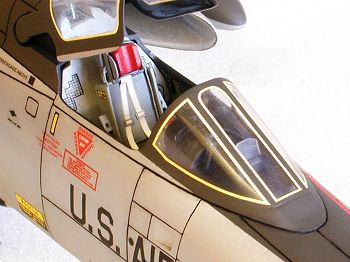 After reassembling the
mock-up and plugging in the stabilators, I took some measurements and compared
them to the published dimensions in Bert Kinzey’s F-105 Thunderchief:
In Detail & Scale. A little high school algebra determined the corrected
model’s actual scale to be approximately 1/45.5—close enough in compatibility
for me.
After reassembling the
mock-up and plugging in the stabilators, I took some measurements and compared
them to the published dimensions in Bert Kinzey’s F-105 Thunderchief:
In Detail & Scale. A little high school algebra determined the corrected
model’s actual scale to be approximately 1/45.5—close enough in compatibility
for me.
The remainder of the assembly consisted of detailing the usual areas and backdating the airframe to depict a pre-camouflage, early ‘60s aircraft. Off came the band-aids on the wings, as well as the appliqué armor and cooling scoops of the aft fuselage. The dorsal spine was removed and the afterburner intake at the base of the fin was reconfigured. Many other vents were modified or eliminated while a new gun access door with the original double purge vents was installed.
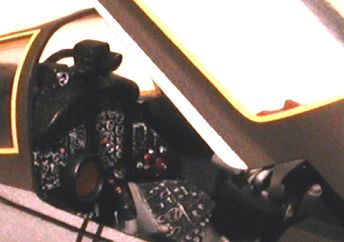 In the cockpit I
overhauled the seat
In the cockpit I
overhauled the seat 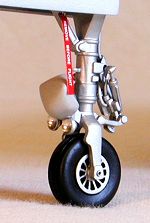 and
replaced the lap and shoulder harness with new paper belts and a Model
Technologies photo-etched set of buckles. I used some bits and pieces to animate
the instrument panel and added a throttle to the left console. The cockpit
sidewalls were detailed with strips of Plastruct and Evergreen and I added some
wiring to the gun sight and instrument panel coaming.
and
replaced the lap and shoulder harness with new paper belts and a Model
Technologies photo-etched set of buckles. I used some bits and pieces to animate
the instrument panel and added a throttle to the left console. The cockpit
sidewalls were detailed with strips of Plastruct and Evergreen and I added some
wiring to the gun sight and instrument panel coaming.
Though the landing gear was extremely well-done, I removed the molded brake and hydraulic lines from the struts and replaced them with bits of Detail Associates model car ignition wire. I drilled out all the landing and taxi lights and installed MV lenses in their stead. Almost as an afterthought I cut new treads in all three tires.

 The poorly-molded arresting hook was DXed in
favor of a totally scratch-built unit, using laminated Evergreen sheet,
stainless steel tubing and pins, and a modified claw from Monogram’s F-104 kit.
The ‘Y’ pipe was built with #23 hypodermic needles while the fuel dump tube was
replaced with an equivalently-sized piece of K & S aluminum tubing, partially
crushed into an oval cross-section and beveled at the end.
The poorly-molded arresting hook was DXed in
favor of a totally scratch-built unit, using laminated Evergreen sheet,
stainless steel tubing and pins, and a modified claw from Monogram’s F-104 kit.
The ‘Y’ pipe was built with #23 hypodermic needles while the fuel dump tube was
replaced with an equivalently-sized piece of K & S aluminum tubing, partially
crushed into an oval cross-section and beveled at the end.
The inner diaphragm afterburner iris on part 25 was removed and replaced by a section of Monogram’s F-100 tailpipe, then the part was attached to the fuselage. Ill-fitting and massively dimpled, multiple fills with CA and much sanding were needed to achieve an acceptable fit. I discarded the downward-hinged petal (part 77), replacing it with a standard piece left over from an F-105G kit.
Rather than fill holes resulting from removal of the RHAW antennas on the fin cap, I elected to remove the entire cap and replace it with a new solid piece cut from a Monogram A-7 pylon. Molded in an appropriate dielectric gray, I notched the leading edge and added a strip of black styrene to replicate the TACAN antenna element.
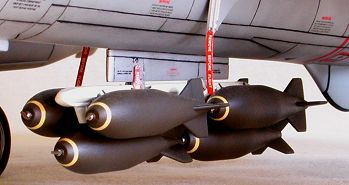 The droptanks were removed
from the pylons, assembled, then fitted with steel pins to facilitate
re-installation to the pylons after painting and decaling. I treated the
centerline pylon the same way, but replaced the bomb rack with a MER from
Hasegawa’s weapon set ‘A’. All the ordnance was replaced with Hasegawa items
from the various sets as well except for the AIM-9B’s launch rail, which was
modified from a Monogram F-4C part.
The droptanks were removed
from the pylons, assembled, then fitted with steel pins to facilitate
re-installation to the pylons after painting and decaling. I treated the
centerline pylon the same way, but replaced the bomb rack with a MER from
Hasegawa’s weapon set ‘A’. All the ordnance was replaced with Hasegawa items
from the various sets as well except for the AIM-9B’s launch rail, which was
modified from a Monogram F-4C part.
After installing mounting pins in all the external stores I drilled holes in
the pylons then checked and adjusted the fit. When I was satisfied I rescribed
the surface detail on the airframe and the pylons, then glued the pylons to the
wings. I scratch-built a canopy actuator that permitted a removable glue-less
 installation of the glass,
attached the windscreen with CA, then turned my attention to the external
lights.
installation of the glass,
attached the windscreen with CA, then turned my attention to the external
lights.
The wingtips received the usual red and green position lights made from shaped and polished Lexan, while the clear light on the fin was built as a bezel and fitted into a rectangular slot cut all the way through the fin. Forward and adjacent to the refueling receptacle I installed a small square of clear styrene with a hole drilled into the backside and filled with red paint to replicate the aerial refueling marker.
Holes were drilled into the nose at the appropriate locations to mount an AOA transducer and an outside air temperature probe after painting and decaling. Likewise, an oil drain tube was installed on the right side of the rear fuselage. After a final sanding and inspection the Thud was towed to the paint shop.
|
PAINT & DECALS |
After masking the cockpit glass, darkened Modelmaster FS 34087 Olive Drab was sprayed on the upper fuselage and forward areas of the droptanks. Allowing for sufficient curing, I masked and shot gloss black on the radome and the painted portion of the pitot tube. Moving aft, the dielectric panels of the ventral fin were sprayed FS 36375 Gray with a black strip simulating the command radio antenna.
After a couple of weeks I masked the anti-glare areas, the radome, the antennas, and the position lights, then sprayed Testor’s Chrome Silver overall to include the gear door interiors and the wells. A field-expedient cradle, constructed from a cardboard box, was instrumental for holding the model during the painting phases. Notched at one end to support the radome, with a magic marker stuck through the other to act as a spindle inserted into the tailpipe, this cradle permitted full 360-degree rotation which I would later appreciate during decaling operations.
All masking was removed immediately upon completion of the painting and I installed the main gear wheels to allow the model to sit upright as it dried. With the painting chores accomplished, I turned my attention to locating the necessary decals.
 Long ago I had become
infatuated with a photo that appeared on page 344 of the September, 1965 issue
of National Geographic illustrating a flightline full of F-105s from the
23rd TFW while TDY to Hickam AFB, Hawaii. Clad in lacquered aluminum
and wearing the unit’s trademark sharkmouth, to me they epitomized the
Thunderchief’s halcyon pre-war era.
Long ago I had become
infatuated with a photo that appeared on page 344 of the September, 1965 issue
of National Geographic illustrating a flightline full of F-105s from the
23rd TFW while TDY to Hickam AFB, Hawaii. Clad in lacquered aluminum
and wearing the unit’s trademark sharkmouth, to me they epitomized the
Thunderchief’s halcyon pre-war era.
SuperScale had released a sheet featuring this scheme some time ago, but since the demise and subsequent reorganization of the company, many sheets had become difficult, if not impossible to locate. Fellow Thud aficionado Paul Osborne located a set for me in the Toronto area, and after a week’s wait the USPS finally delivered them and I was back in business.
Supplementing these decals with items from the Aeromaster F-84 stencil sheet and the Albatross Thunderchief release, I was able to portray a typical Thud wearing a modest amount of service markings. Testor’s Dullcote was used overall to seal the decals and level the paint. I used powdered graphite applied with a small brush to burnish the cannon’s muzzle brake, simulating the darker, unpainted stainless steel panel. Likewise, I tinted the speedbrake petals as heat often discolored these areas after only minimal use. When done, I used a dark gray watercolor wash to highlight the recessed details, followed by another, lighter misting of flat lacquer to seal the weathering.
When the final coat had dried I plugged the ordnance into their respective pylons, installed the canopy, then built a set of ‘remove before flight’ tags and added them to the pylons, landing gear, and arresting hook. White glue was used to attach the AOA indicator and temperature probe, while a pair of Monogram F-100 boarding ladders were cobbled together for their new mission, providing pilot access to the Thunderchief.
|
CONCLUSIONS |
This is the worst kit I have EVER built, and certainly the worst kit that Monogram has ever released. I recommend this kit to no one unless; A) they are willing to accept shape, accuracy, and fit problems, or B) they are willing (and capable) of doing something about them. This is the sole choice for a Thunderchief in this scale, so I leave it to the individual modeler to decide. One can only hope for a new-tool wunderkit from Japan or elsewhere. On a personal note I offer my gratitude to Paul Osborne (one of the true ‘good guys’) in Canada for graciously finding and sending the necessary decals, and to C. J. Lane in Oregon for providing the hapless MiG-25 kit (thanks, Gyrene!).

|
REFERENCES |
Modern Military Aircraft: Thud – Lou Drendel; Squadron-Signal Publications
Century Series In Color – Lou Drendel; Squadron-Signal Publications
F-105 Thunderchief In Action – Lou Drendel; Squadron-Signal Publications
USAF Europe In Color – Robert Robinson; Squadron-Signal Publications
National Geographic, Vol. 128, No. 3, September 1965
F-105 Thunderchief: In Detail & Scale – Bert Kinzey; Tab Books, Inc.
Airpower, Vol. 11, No. 1, January 1981; Sentry Books, Inc.
The Republic F-105 Thunderchief – Robert D. Archer; Aero Publishers, Inc.
Koku-Fan, September 1979; Bunrin-Do Publishing
Cold War Thuds: The F-105 Thunderchief in Europe, 1961-1968
– An excellent web page with an emphasis on the pre-camouflage service of the F-105 in Europe. Run by Dave Gurtner, an old Thunderchief hand, the site features numerous unpublished photos, specifications, line drawings, ordnance data (including ‘special weapons’), anecdotes, and links to other interesting and related material.Ó 2001 by Roger M. Jackson
If you would like your product reviewed fairly and quickly by a site that gets thousands of visits a day, please contact me or see other details in the Note to Contributors.